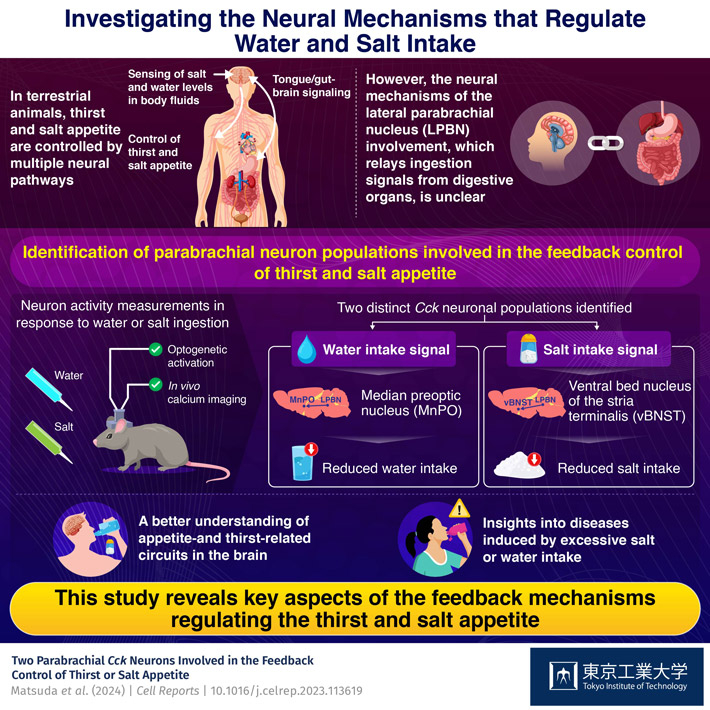Neural mechanisms underlying the regulation of thirst and salt appetite upon ingestion, remain unclear. Now, researchers from Tokyo Tech have conducted experiments on genetically engineered mice and found distinct neuronal populations in the brain’s parabrachial nucleus that serve as feedback mechanisms to prevent excessive water and salt intake. Their efforts could help better understand several diseases and pave the way to potential treatment strategies.

Staying hydrated and consuming appropriate amounts of salt is essential for the survival of terrestrial animals, including humans. The human brain has several regions constituting neural circuits that regulate thirst and salt appetite, in intriguing ways.
Previous studies suggested that water or salt ingestion quickly suppresses thirst and salt appetite before the digestive system absorbs the ingested substances, indicating the presence of sensing and feedback mechanisms in digestive organs that help real-time thirst and salt appetite modulation in response to drinking and feeding. Unfortunately, despite extensive research on this subject, the details of these underlying mechanisms remained elusive.
To shed light on this matter, a research team from Japan has recently conducted an in-depth study on the parabrachial nucleus (PBN), the brain’s relay center for ingestion signals coming from digestive organs. Their latest paper, whose first author is Assistant Professor Takashi Matsuda from Tokyo Institute of Technology, was on January 23, 2024.
The researchers conducted a series of in vivo experiments using genetically engineered mice. They introduced optogenetic (and chemogenetic) modifications and in vivo calcium imaging techniques into these mice, enabling them to visualize and control the activation or inhibition of specific neurons in the lateral PBN (LPBN) using light (and chemicals). During the experiments, the researchers offered the mice—either in regular or water- or salt-depleted conditions—water and/or salt water, and monitored neural activities along with the corresponding drinking behaviors.
In this way, the team identified two distinct subpopulations of cholecystokinin mRNA-positive neurons in the LPBN, which underwent activation during water and salt intake. The neuronal population that responds to water intake projects from the LPBN to the median preoptic nucleus (MnPO), whereas the one that responds to salt intake projects to the ventral bed nucleus of the stria terminalis (vBNST). Interestingly, if the researchers artificially activated these neuronal populations through optogenetic (genetic control using light) experiments, the mice drank substantially less water and ingested less salt, even if they were previously water- or salt-deprived. Similarly, when the researchers chemically inhibited these neurons, the mice consumed more water and salt than usual.
Therefore, these neuronal populations in the LPBN are involved in feedback mechanisms that reduce thirst and salt appetite upon water or salt ingestion, possibly helping prevent excessive water or salt intake. These results, alongside their previous neurological studies, also reveal that MnPO and vBNST are the control centers for thirst and salt appetite, integrating promotion and suppression signals from several other brain regions. “Understanding brain mechanisms controlling water and salt intake behaviors is not only a significant discovery in the fields of neuroscience and physiology, but also contributes valuable insights to understand the mechanisms underlying diseases induced by excessive water and salt intake, such as water intoxication, polydipsia, and salt-sensitive hypertension,” remarks Dr. Matsuda.
Prof. Noda mentions, “Many neural mechanisms governing fluid homeostasis remain undiscovered. We still need to unravel how the signals for inducing and suppressing water and salt intake, accumulated in the MnPO and vBNST, are integrated and function to control intake behaviors.”
Reference
Authors : | Takashi Matsuda1, Kenta Kobayashi2, Kazuto Kobayashi3, and Masaharu Noda1,* |
Title : | Two parabrachial Cck neurons involved in the feedback control of thirst or salt appetite |
Journal : | Cell Reports |
DOI : | |
Affiliations : | 1³Ô¹ÏÍøÕ¾ostatic Mechanism Research Unit, Institute of Innovative Research, Tokyo Institute of Technology, Japan 2Section of Viral Vector Development, ³Ô¹ÏÍøÕ¾ Institute for Physiological Sciences, Japan 3Department of Molecular Genetics, Institute of Biomedical Sciences, Fukushima Medical University School of Medicine, Japan |







